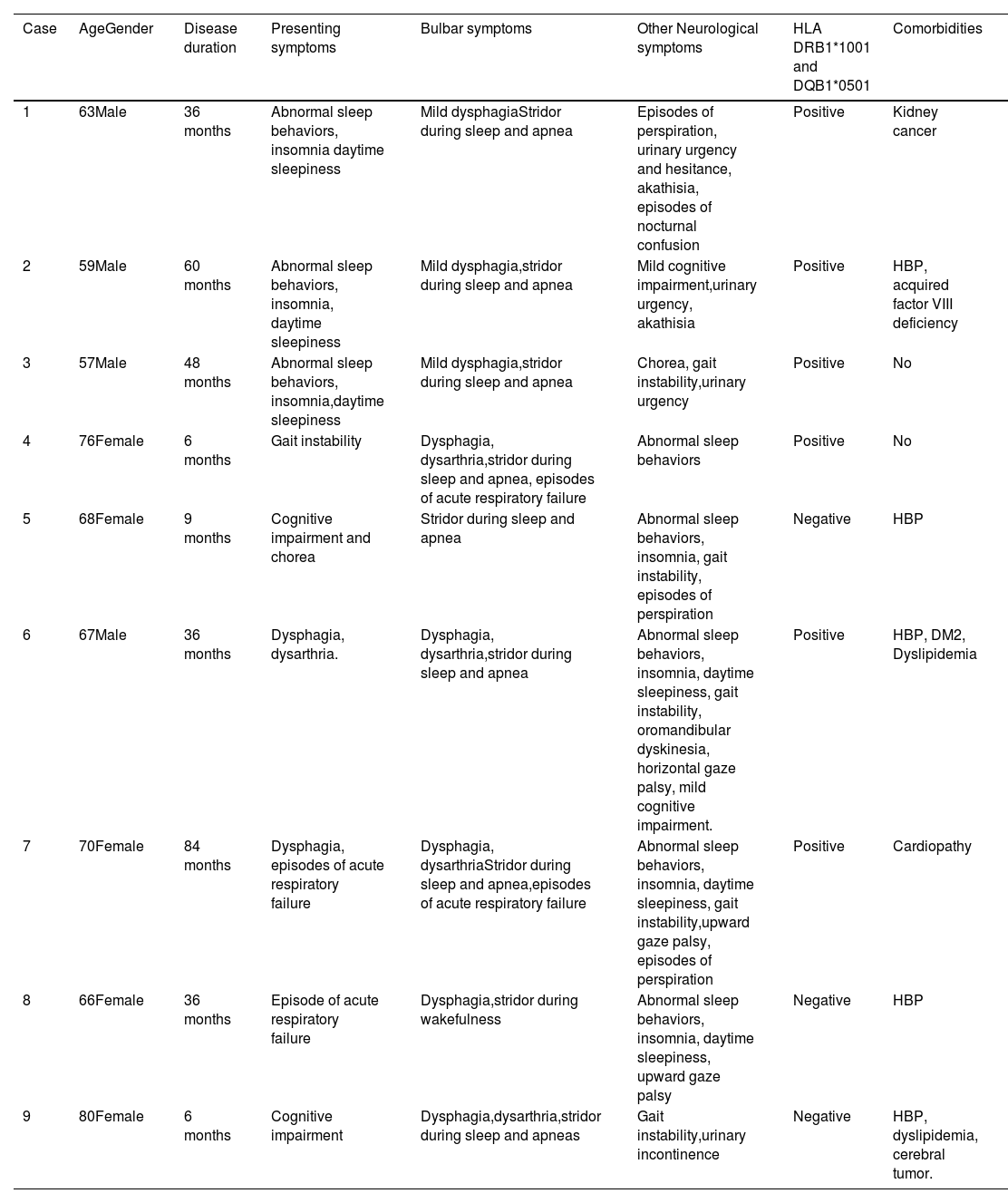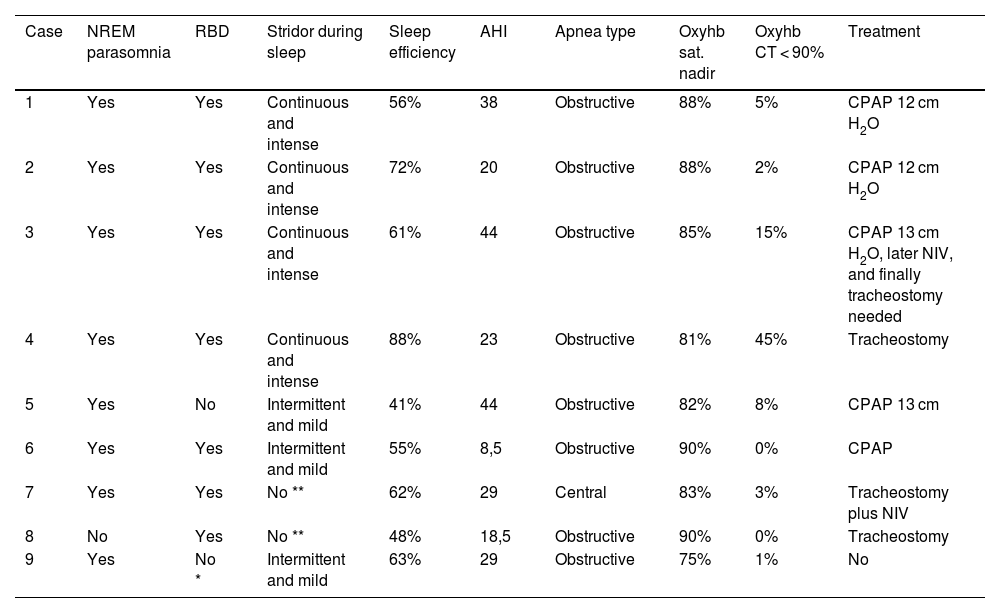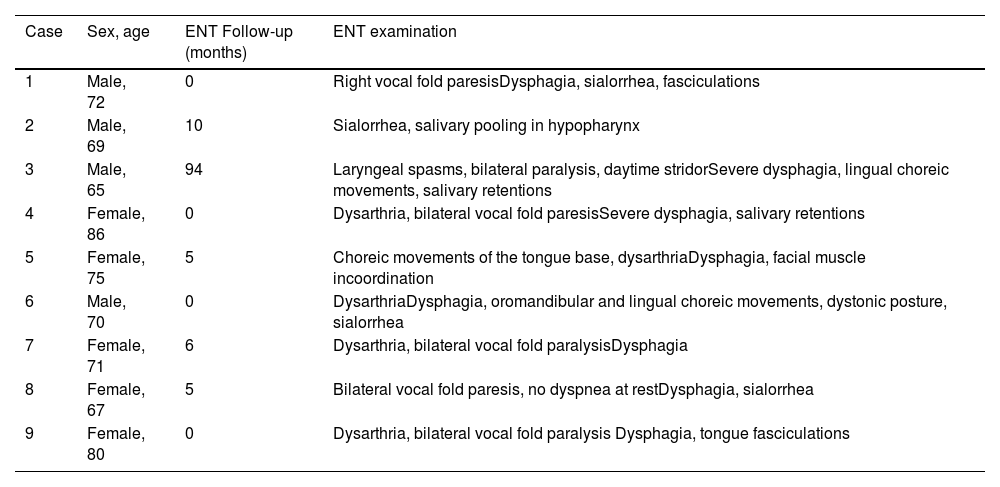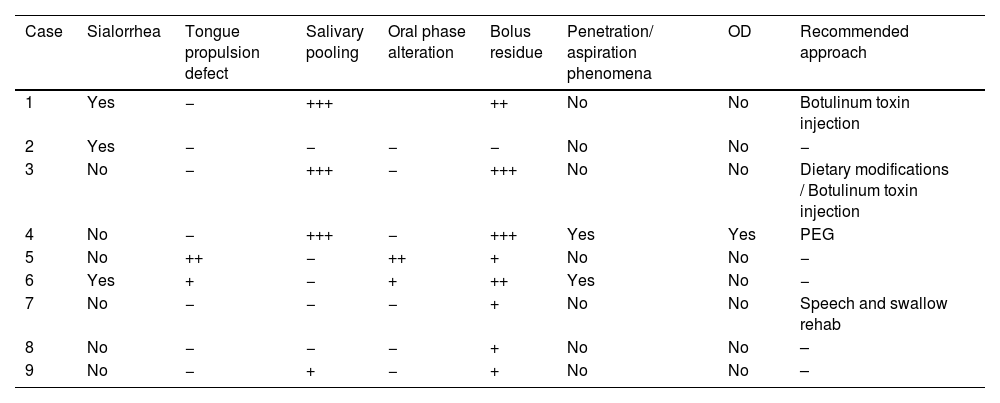Anti-IgLON5 disease is a recently described neurological disorder with multisystemic features. The disease is characterized by the presence of IgLON5 antibodies in serum and cerebrospinal fluid. Our objective is to describe in detail the otorhinolaryngological manifestations of this disease, which are frequent and may include dysphagia, dysarthria, vocal cord paralysis and laryngospasm.
MethodsIn this study, we present a series of 9 patients with anti-IgLON5 disease and otolaryngological manifestations. Patients were evaluated between July 2012 and March 2022 by video-polysomnography, fiber-optic laryngoscopy, and functional endoscopic evaluation of swallowing.
ResultsThe median age was 71 years, and 5 (56%) were female. Video-polysomnography showed a NREM/REM parasomnia in 6 patients (67%), obstructive sleep apnea in 8 (88%), stridor during sleep in 7 (78%) and central apneas in 1 (11%). Six out of the 9 patients (67%) presented episodes of acute respiratory failure that required mechanical ventilation, 6 had vocal fold palsy with 4 of them requiring tracheostomy (3 had to be performed on an emergency basis). Dysphagia occurred in 8 patients (89%). Prominent upper airway secretion and sialorrhea was also present in 3 cases.
ConclusionThe anti-IgLON5 disease exhibits extensive otolaryngological symptoms, mainly affecting the upper airway. These symptoms affect the quality of life and can be life-threatening. Prompt acute management is essential for stridor, dyspnea, and dysphagia. Given the potential severity of the symptoms and rarity of the disease, it is important for otolaryngologists to be familiar with anti-IgLON5 disease.
Level of evidenceLevel 4.
La enfermedad anti-IgLON5 es un trastorno neurológico descrito recientemente con características multisistémicas. La enfermedad se caracteriza por la presencia de anticuerpos IgLON5 en suero y líquido cefalorraquídeo. Nuestro objetivo es describir en detalle las manifestaciones otorrinolaringológicas de esta enfermedad, que son frecuentes y pueden incluir disfagia, disartria, parálisis de las cuerdas vocales y laringoespasmo.
MétodosEn este estudio presentamos una serie de 9 pacientes con enfermedad anti-IgLON5 y manifestaciones otorrinolaringológicas. Los pacientes fueron evaluados entre julio de 2012 y marzo de 2022 mediante videopolisomnografía, nasofibrolaringoscopia y videodeglución asistida.
ResultadosLa mediana de edad fue de 71 años, y 5 (56%) eran mujeres. La videopolisomnografía mostró una parasomnia NREM/REM en 6 pacientes (67%), apnea obstructiva del sueño en 8 (88%), estridor durante el sueño en 7 (78%) y apneas centrales en 1 (11%). Seis de los 9 pacientes (67%) presentaron episodios de insuficiencia respiratoria aguda que requirieron ventilación mecánica, 6 tenían parálisis de las cuerdas vocales y 4 de ellos precisaron traqueostomía (3 en contexto de atención urgente). Ocho pacientes presentaron disfagia (89%). También se observó secreción prominente de la vía aerodigestiva superior y sialorrea en 3 casos.
ConclusionesLa enfermedad anti-IgLON5 presenta amplios síntomas otorrinolaringológicos, que afectan principalmente a la vía aerodigestiva superior. Estos síntomas afectan la calidad de vida y pueden desencadenar la muerte. El tratamiento agudo inmediato es esencial para el estridor, la disnea y la disfagia. Dada la gravedad potencial de los síntomas y la rareza de la enfermedad, es importante que los otorrinolaringólogos estén familiarizados con la enfermedad anti-IgLON5.
Nivel de evidencia4.










